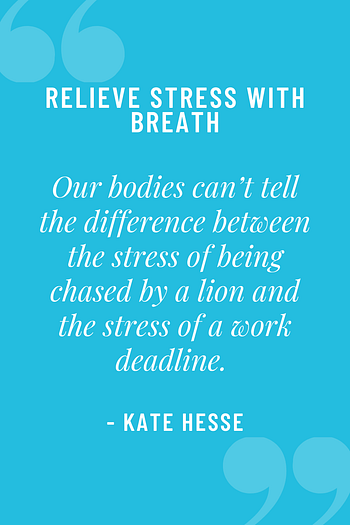
If you came here looking for additional information on the Sympathetic and Parasympathetic Nervous System states, you can read a more recent in-depth post here!
 Just breathe. Don’t forget to breathe. Are you remembering to breathe?
Just breathe. Don’t forget to breathe. Are you remembering to breathe?
We hear it all the time, in yoga class, from friends, in advertising, on the news, and from me (it’s in the name of my business!), but what do people actually mean when they say it?
Our bodies take in air without our thinking about it. If respiration is an autonomic response – why should you have to think about breathing?
Autonomic breathing is about survival, our bodies take in enough oxygen to survive. But you deserve so much better – you deserve to thrive.
You can control your stress by the way you breathe
 Most babies and children breathe deep into their bellies, part of this is due to their anatomy (you can read more about anatomy and breathing in this article), but part of this is because they haven’t yet taken on the stresses which cause so many of us to live in a state of fight-or-flight throughout our daily lives.
Most babies and children breathe deep into their bellies, part of this is due to their anatomy (you can read more about anatomy and breathing in this article), but part of this is because they haven’t yet taken on the stresses which cause so many of us to live in a state of fight-or-flight throughout our daily lives.
Let’s talk about stress for a minute.
Our bodies can’t tell the difference between the stress of being chased by a lion and the stress of a work deadline, three hours of errands to run in a one-hour lunch break, bills you forgot to pay (or don’t have the money to pay), a social commitment you wish you could get out of, or rushing to get dinner on the table for your over-hungry family.
All of these, and so much more, the body interprets as potential danger. Your body responds to this stress by triggering a sympathetic nervous system response (frequently referred to as fight-or-flight).
Chronic stress vs. actual danger
Chronic stress differs from actual danger in one critical way. When faced with actual danger, the fight-or-flight response triggers a surge of adrenaline (and other stress hormones) to help you survive an actual physical threat. Once you’re safe, your body returns to a relaxed state.
However, when dealing with chronic stress, something most of us encounter in modern life, there isn’t an end. Chronic stress means we’re constantly in a state of fight-or-flight.
And living in a sympathetic nervous system state can have a number of detrimental health effects.
The impact of stress on how you breathe
Shallower and shorter breaths are a result of this constant engagement of your sympathetic nervous system. Your body is preparing to survive, it isn’t worried about thriving.
By the time they reach adulthood, modern Americans are expected to be shallow chest breathers, no longer taking the long, slow, deep belly breaths which are part of the parasympathetic nervous system response (commonly referred to as rest-and-digest).
Several years ago, I was at the doctor’s office having a rather uncomfortable but routine procedure done. As I began to take long deep belly breaths to help relax my body through the procedure, the nurse who was assisting anxiously asked if I was ok.
Reflecting back after it was all over, I couldn’t understand the cause for the fear I heard in the nurse’s voice.
However, a few weeks later I was talking to a friend who’s a nurse, she noted that she was trained to recognize belly breathing in adults in a medical situation as a sign of distress. It didn’t occur to the nurse in my situation that I was intentionally focusing on my breathing to encourage a parasympathetic nervous system response in my body.
Relearning how to breathe
Belly breathing is also referred to as diaphragmatic breathing.
I know where my belly is. Until I took anatomy as part of my yoga teacher training, I couldn’t accurately put my hand on the part of my body where my diaphragm was. So for those of us with a less than perfect grasp on human anatomy, I use the term belly breathing.
Think about your breathing – when you’re not paying attention to it, what’s the quality of your breath? Are you taking deep breaths, tunneling down into your belly, or are you taking shallow breaths which barely expand your rib cage?
Many years ago when I started practicing yoga, I had to relearn how to breathe, I had to learn to fully fill my body with air with each inhale and fully expel that air with each exhale.
Now when I turn my focus to my breathing, that happens automatically. However, when I’m stressed, anxious, or overwhelmed, my breath gets shorter and shallower, my body is just taking in the oxygen it needs to survive and focusing energy on the other tasks at hand.
Regularly returning my attention to my breath, taking a few (or several) full, slow, deep inhales and exhales signals to my body that I’m safe, it can shift from fight-or-flight to rest-and-digest.
These breaths help fully oxygenate my body, providing the resources all my organs and systems need to function. And it helps me to bring my mind into the present moment, to become aware of the world around me and appreciate how special it is.
Physical benefits of deep belly breathing
The physical benefits of deep belly breathing are many – Harvard Medical School reports that when taking shallow breaths, “the lowest portion of the lungs — which is where many small blood vessels instrumental in carrying oxygen to cells reside — never gets a full share of oxygenated air. That can make you feel short of breath and anxious.”
They continue to add “Deep abdominal breathing encourages full oxygen exchange — that is, the beneficial trade of incoming oxygen for outgoing carbon dioxide.
Not surprisingly, this type of breathing slows the heartbeat and can lower or stabilize blood pressure.”
You can also read more about the physical and mental impact of both belly breathing and chest breathing from the United Kingdom’s National Health Services here. If you click on any link in this article, I suggest this one, I particularly like the accessible nature of the material in this pamphlet.
If you aren’t comfortable with the concept of belly breathing or are not sure you are doing it right, here are a few tips:
Start practicing this technique lying down on your back, with a pillow or blanket folded up under your knees. Your back should be long and straight on the ground. You may want a small pillow under your head to provide a little support, however, be sure you’re not restricting your airway by tilting your forehead up too high. Laying on your back is helpful as it’s much easier to focus on your breath if you are not also worrying about your posture – here you’re allowing the floor to keep your spine in alignment.
Gently rest one hand on your belly right below your belly button and one hand on your chest above your heart. This hand placement will help you feel where in your body you’re breathing. As you inhale, you’ll feel your body expand and as you exhale, it will contract.
It’s important that your hands are gently resting on your body, you don’t want to be placing pressure on your belly or chest which will constrict your ability to breathe.
Take a deep breath in, focus on driving that breath down into your belly. You should feel your hand on your belly rise. If you only feel the hand on your chest rise, continue to visualize the breath moving down into your belly. Focus on slow inhalations and exhalations and directing the breath down toward your belly.
It may take you some time before you’re able to feel the breath moving into your belly. Remember you’re learning to do something new with your body – you wouldn’t expect a child to learn how to ride a bike in an instant, extend the same understanding to your self.
Once you feel your belly expand on each inhalation and fall on each exhalation, you can begin to lengthen your breath. Slowly begin to take in longer and fuller breaths, feeling your belly rise and your chest expand on the inhale, then your rib cage and belly fall on the exhale. With practice you may even begin to feel your collar bones lift at the end of the inhale as you fully fill your body with air.
Note that if you are fully filling your body, your breathing should be much slower than your normal breathing rate (or even belly breathing alone). My normal autonomic breath rate is around 17 breaths per minute, my full body breathing rate (belly to collar bones) is at 4 breaths per minute.
These are the numbers that work for my body, your body will breathe at your own pace, I’m sharing simply to give you an example of the difference in the speed of inhalation and exhalation between the two types of breathing.
You should never feel lightheaded while practicing this (or any other breathing technique). In the event that you do feel lightheaded, release the technique and allow your body to relax and breathe normally.
Ready for the guided audio!
As you grow more comfortable with this breath, continue to focus on slowing down your inhalations and exhalations, allowing your body to slowly sip in the air and slowly release it back out of your body.
Once you feel your body relax and you’re ready to release the breathing technique, just bring your focus back to the room, allow your body to take a few natural breaths before returning to what you were doing.
With practice, you’ll be able to employ this technique anywhere at any time, you won’t need to lie down or bring your hand to your belly. You’ll simply be able to bring your focus to your breathing and direct your breath down into your belly while slowing down your inhales and exhales.
(If you find this breathwork helpful, check out my post on the Audible Exhale which is also a fantastic breath to help you release stress and tension!)
So back to the original question
When someone tells you to just breathe, what they’re really saying (whether they understand the bio-mechanics on a conscious level or not) is – “Hi, I noticed that you seem stressed or anxious, I think it will help you calm down if you focus on your breathing and try and shift your body from fight-or-flight to rest-and-digest.” Being able to recognize this in yourself is a critical component of self-care.
When you start feeling anxious, stressed, or overwhelmed by life, or when you realize your shoulders are hunched so far up they’re almost touching your ears, pause and take a few deep belly breaths.
Continue to take these belly breaths until you start to feel your body relax and the racing in your mind slows.
While you take these breaths, take a moment, thank your body for keeping you alive, thank it for helping you to survive. And then let it know that you’re taking a moment to support it with full deep belly breaths – giving yourself what you need to thrive.
We each move through life one breath at a time – take time to make sure your breath helps you thrive!
Related
4 thoughts on “Learn how to breathe to relieve stress!”
Leave a Reply Cancel reply
This site uses Akismet to reduce spam. Learn how your comment data is processed.
[…] Dr. Weil notes that “By imposing this rhythm on your breathing with your voluntary nerves and muscles, you will begin to influence your involuntary nervous system toward more balanced functions, with great benefits to overall health.” (The emphasis is mine.) To learn more about the sympathetic and parasympathetic nervous system responses, read my post here. […]
[…] Ready to help detox your body through breathing? If you are new to breathwork, start with a basic belly breath (guided audio below) which will help you learn what it feels like to practice diaphragmatic breathing. You can use the audio below, and learn more about the breath practice here. […]
[…] in real life triggers a fight, flight or freeze sympathetic nervous system response (learn more here). When your mind is unsure if what you are watching is reality or fiction, it will respond by […]
[…] Additionally, humming has been shown to reduce stress and lower heart rate and blood pressure.3 Simply by humming, you are able to help your body trigger a parasympathetic nervous system response – shifting into a mode of rest and digest. (Read more about the benefits of being in a parasympathetic nervous state here) […]